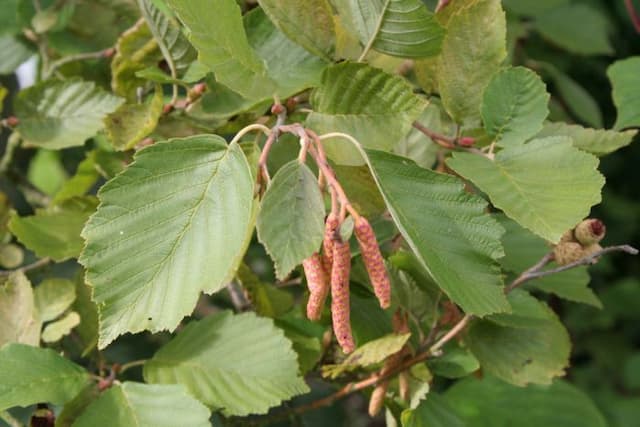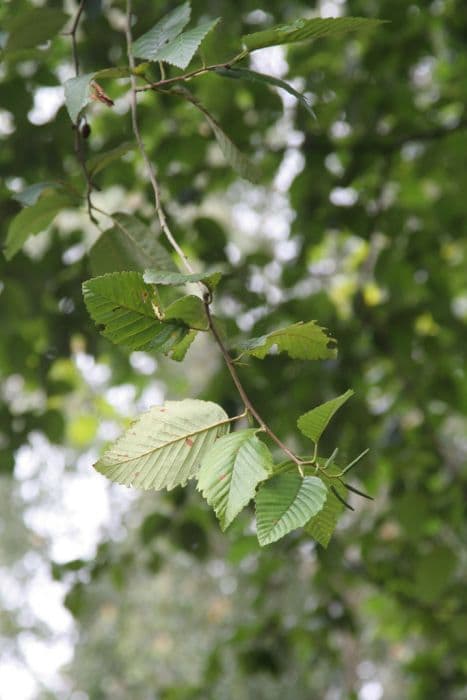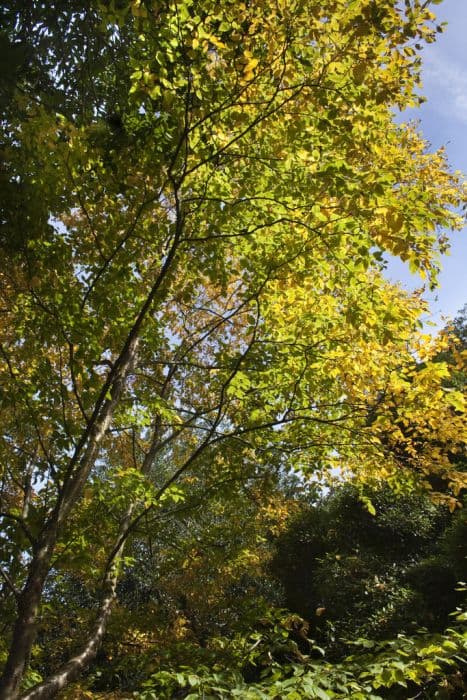Young's Weeping Birch Betula pendula subsp. pendula 'Youngii'

ABOUT
The plant commonly known as the Young's Weeping Birch is notable for its elegant, pendulous form. Its branches cascade downwards, creating a distinctive and graceful silhouette. The tree's leaves are delicate and diamond-shaped, sporting a bright green color that turns to a vibrant yellow in the fall, adding seasonal interest to any landscape it graces. The bark of the Young's Weeping Birch is particularly striking: it peels off in papery strips, revealing layers of creamy white with black cracks and markings. During the springtime, this tree produces catkins, which are long and slender, hanging decoratively from the branches, adding a touch of charm early in the season. The fine texture of its foliage combined with the weeping branches gives the Young's Weeping Birch an airy and whimsical appearance, making it a beautiful ornamental plant for gardens.
About this plant
 Names
NamesFamily
Betulaceae.
Synonyms
Young's Weeping Birch, European White Birch, Weeping Silver Birch.
Common names
Betula pendula 'Youngii'.
 Toxicity
ToxicityTo humans
The European white birch, often known as Betula pendula subsp. pendula 'Youngii', is generally not considered toxic to humans. There are no commonly recognized symptoms of poisoning from this plant, as it is not known to possess toxic substances in amounts significant enough to cause harm upon ingestion. Thus, unintentional consumption of parts of this birch is unlikely to result in serious consequences for humans.
To pets
The European white birch, known as Betula pendula subsp. pendula 'Youngii', is also not considered toxic to pets. It does not contain substances that are known to be harmful to animals if ingested. Consequently, ingestion of this plant by pets, such as cats or dogs, does not typically lead to poisoning or serious health issues.
 Characteristics
CharacteristicsLife cycle
Perennials
Foliage type
Deciduous
Color of leaves
Green
Height
13 feet (4 meters)
Spread
13 feet (4 meters)
Plant type
Tree
Hardiness zones
2
Native area
Europe
Benefits
 General Benefits
General Benefits- Aesthetic Appeal: Adds visual interest to landscape with its distinctive weeping form.
- Wildlife Habitat: Provides shelter and food for birds and other wildlife.
- Shade Provision: Creates shaded areas in gardens, which can lower local temperatures and provide a comfortable outdoor space.
- Seasonal Interest: Offers varying visual interest through the seasons, including spring foliage, autumn color, and winter structure.
- Erosion Control: Roots help stabilize the soil and prevent erosion.
- Low Maintenance: Generally requires minimal care once established, making it suitable for a variety of landscape settings.
- Adaptability: Tolerant to a range of soil types and conditions, allowing it to thrive in many environments.
- Urban Tolerant: Able to withstand urban conditions such as pollution and confined spaces.
 Medical Properties
Medical PropertiesThis plant is not used for medical purposes.
 Air-purifying Qualities
Air-purifying QualitiesThis plant is not specifically known for air purifying qualities.
 Other Uses
Other Uses- Woodworking: The wood of the European birch is highly valued for its fine grain and attractive markings, often used in veneer production and furniture making.
- Dyeing: The bark contains substances that can be used for dyeing fabrics a light brown or beige color.
- Photography: Birch bark has been used historically as a base material for early forms of photographic paper.
- Food Flavoring: The sap of the birch can be used to make birch syrup, which is used as a flavoring agent in various foods.
- Craft Materials: The flexible branches are sometimes utilized in crafts for making items such as baskets and decorative objects.
- Fishing: Historically, the bark has been used to make canoes and fishing gear by indigenous peoples.
- Landscaping: The weeping habit of 'Youngii' makes it a unique ornamental tree for gardens and parks.
- Tanning Leather: The bark contains tannins that are useful in the leather-making process to tan hides.
- Children's Toys: Lightweight and durable, birch wood can be crafted into toys and model making.
- Instrument Making: Birch wood's acoustic properties allow it to be utilized in the manufacture of drums and other musical instruments.
Interesting Facts
 Feng Shui
Feng ShuiThe Young's Weeping Birch is not used in Feng Shui practice.
 Zodiac Sign Compitability
Zodiac Sign CompitabilityThe Young's Weeping Birch is not used in astrology practice.
 Plant Symbolism
Plant Symbolism- Adaptability - Betula pendula, commonly known as Silver Birch, is a resilient species that can thrive in a variety of conditions, representing the ability to adapt and prosper.
- Purification - The Silver Birch has been associated with cleansing and purification, both in physical and spiritual contexts, due to its light, airy foliage and the traditional use of its sap.
- New Beginnings - With its penchant for being one of the first trees to repopulate land after disturbances, Silver Birch symbolizes hope and new starts.
- Protection - In folklore, the Silver Birch was often linked to protection against evil and negativity, hence planting it was considered as bringing a safeguard to the area.
 Water
WaterYoung's Weeping Birch should be watered deeply and thoroughly, allowing the soil to become moist but not waterlogged. During the active growth period in spring and summer, water approximately every 7-10 days, providing 1.5-2 gallons per watering session for a young tree, and more for mature trees depending on their size. In hot and dry conditions, you may need to water more frequently. Reduce watering in the fall and water sparingly in winter, just enough to prevent the soil from completely drying out.
 Light
LightYoung's Weeping Birch thrives in full sunlight, meaning it should receive at least 6 hours of direct sun per day. An ideal spot for the plant is an open area with unfiltered sun exposure. The tree can tolerate some light shade, particularly in the hottest parts of the day, but the best growth and form are achieved in full sun.
 Temperature
TemperatureYoung's Weeping Birch is hardy and can withstand cold winters, with a capability to survive temperatures down to around -40 degrees Fahrenheit. During the growing season, the ideal temperature range lies between 50 and 70 degrees Fahrenheit. They can also tolerate higher temperatures, but may require additional watering if temperatures frequently exceed 80 degrees Fahrenheit.
 Pruning
PruningYoung's Weeping Birch benefits from pruning to maintain its weeping form and remove any dead or diseased branches. Prune in late winter or early spring before new growth begins. This is also the time to shape the tree or correct any structural imbalances. Pruning may be required yearly, but always aim to remove as little as necessary to preserve the tree's natural shape.
 Cleaning
CleaningAs needed
 Soil
SoilThe Young's Weeping Birch thrives in well-draining, loamy to sandy soil with a pH range from slightly acidic to neutral. A mix of one-third sand, one-third garden soil, and one-third peat or compost is ideal to provide the right structure and nutrients.
 Repotting
RepottingAs Young's Weeping Birch is a tree, it is not typically repotted. It is planted outdoors and allowed to grow without repotting.
 Humidity & Misting
Humidity & MistingYoung's Weeping Birch prefers moderate humidity conditions but is adaptable and can thrive in the varying humidity levels found in most outdoor environments.
 Suitable locations
Suitable locationsIndoor
Not suited for indoors; requires open space, sun, and well-draining soil.
Outdoor
Plant in full sun, provide ample water, and ensure soil drainage.
Hardiness zone
2-7 USDA
 Life cycle
Life cycleThe Young's Weeping Birch (Betula pendula subsp. pendula 'Youngii') begins its life cycle with seed germination, typically occurring in spring when soil temperatures warm up. After germination, it enters the seedling stage, where it prioritizes root development and initial shoot growth. The sapling stage follows as the tree develops its distinctive weeping form, with branches growing downward. The tree reaches maturity in several years, during which it develops its reproductive structures; catkins appear in early spring for wind pollination. The mature tree then produces seeds encased in small cones, completing its reproductive cycle. Throughout its life, the Young's Weeping Birch undergoes annual cycles of leaf growth in the spring and leaf abscission in the fall, coupled with periods of dormancy during the winter months.
 Propogation
PropogationPropogation time
Spring-Early Summer
The European Weeping Birch or Young's Weeping Birch can be propagated through grafting, which is the most popular method for this particular tree. Grafting is typically done during the dormant season, which is late winter or early spring. In this process, a stem with leaf buds is inserted into the stock of a tree, so that the tissues can fuse. The scion, which is the upper part of the graft, should be from a healthy, disease-free plant. It is carefully selected for the quality of the foliage and form that one desires to replicate. The rootstock, generally from a common birch, is chosen for its vigor and adaptability to local conditions. The grafted joint is then bound and sealed to prevent disease and drying out. Over time, the two pieces grow together, forming a new, grafted birch tree that displays the desirable characteristics of the 'Youngii' variety.









